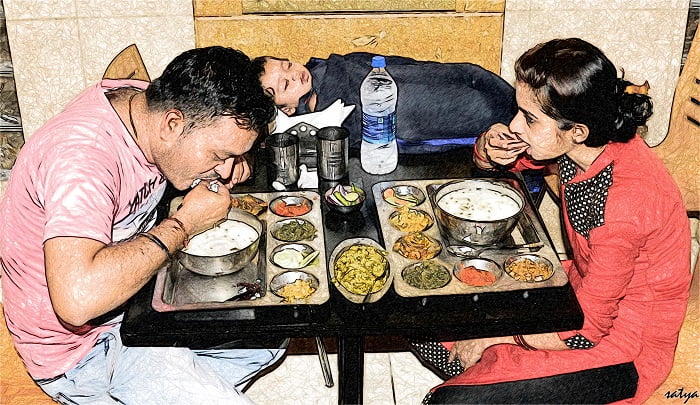Pakhala Bhata – Whose Gruel Is It Anyway?
Can Simple Food Win A Michelin Star!

Pakhala Bhata or Panta Bhat is trending on various social media platforms. It started when one of the finalists, Kishwar Chowdhury, in Master Chef Australia served ‘Smoked Rice Water’ with ‘aloo bharta’ and fried sardines marinated in white soy. What was intriguing to me was that this rice gruel, identified as a poor man’s food, could be passed off as a main dish in the finale. This exposed the poor research by the judges, who showered praises on Kishwar for bringing traditional forgotten, fermented dishes to fine dining.
In fact, Master Chef Australia is late to the party. This dish is known in India by various names – poita bhat (Assamese), pakhala bhat (Odia), pazhaya sadam (Tamil), geel bhat (Bihar), chaddannam (Telugu) and pazhamkanji (Malayalam).
If anyone has followed the episodes – one knows how the backend research team are sure about any recipe and dishes in the culinary world. This dish is basically made by taking leftover cooked rice and leaving it soaked in water in a loosely covered earthen pot till it ferments overnight, or even in a few hours on a hot summer day. It is then seasoned with just salt, or with chutneys, pickles, pungent mustard oil, mashed dal, boiled vegetables, fried fish, or anything else at hand and eaten. This dish of fermented rice is comfort food for many in India.
The finalist was mistaken when she said that Panta Bhat, which I will refer to as Phakala Bhata, is not the kind of food that’s served in restaurants. Three years ago, Pakhala Bhata, was on the menu of the award-winning restaurant The Bombay Canteen under Chef Thomas Zacharias.
Here is one thing which Kishwar did: In breaking away from the hierarchy of tastes that Master Chef represents, she put the dish on a high table representing the toilers of the land. Still, her general knowledge is a little weak – March 20 is being celebrated as ‘Pakhala Dibas’ in Odisha, since 2019, and this event is growing year by year globally.
Search for #pakhala or #PakhalaDibas on social media and one will be flooded with images of elaborate meals where the basic simplicity of the fermented rice is circled by innumerable side dishes. In contrast, #PantaBhat shows just the rice and a few accompaniments, like crisp raw onions, mashed potatoes, chutney and fried fish.

In Odisha, however, people have had a far more consistent relationship with Pakhala as they call it. Popular restaurants, Dalm and Odisha Hotel, in Bhubaneswar, have been serving it for years now.
The word Pakhala is derived from the Pali word, pakhaliba, and the Sanskrit word, prakshalana, which means ‘washed/to wash. It is not known when and how the dish was first included in the diet of eastern India, but it might have found a place in the menu of Jagannath Temple in Puri around the 11th century AD. The reason: ‘Tanka Thorani’ is a go after during the summer and the Lords’ sojourn in the ‘Anasara Ghar’.

Over the years, different varieties of the Pakhala have come about— dahi pakhala; chunka pakhala tempered with curry leaves, green chillies, ginger and cumin seeds; basi or stale; saja pakhala in which water is added to cooked rice and eaten fresh, and the mitha pakhala prepared with the sweet cut of fruits and tempered with roasted cumin.
For the satwik, ‘subhas pakhala’ served as a bhog in the 12th-century shrine in Puri, is perfumed with flowers like jasmine, mogra, frangipani (katha champa), and ginger.
Pakhala evokes some vivid childhood memories too as it was a must during the summers with sautéed greens, leafy vegetables and fritters. The elderly ladies were in charge of making this summer gruel and the siesta thereafter was heavenly.

We need fat varieties of parboiled unpolished rice that will break down and release starch but not the long Basmati type rice which was by the finalist. This fermented rice celebrated as a health drink and gruel by India’s rural people is unlikely to be a palatable product for the urban, uninformed stomach under the spell of the basmati and polished rice.
Restaurants in Bengal now make it for Poila Baisakh, Bengali New Year, when the practice is to eat it with fried hilsa. In Bangladesh, this is so imperative that in 2014 students at Pabna University of Science and Technology, gheraoed officials in protest for not being served Panta Bhat and fried hilsa for breakfast on that day.
Though many of us sniggered during the episode, the rice-eating culinary connoisseur could still feel the connection, though Pakhala still remains rice gruel, the food that one eats to use up leftovers, or soothe an upset stomach or, for someone who one can’t afford much more.
This dish is definitely going to create an interest among the culinary scholars and connoisseurs – a debate, especially where to put it on the food map of India.
For the road, it should not become an issue between Bengal and Odisha. Let the government wake up and go for Pakhala Bhat GI Tag.
[Disclaimer: The views expressed by the author are personal and do not necessarily represent that of the website]

Comments are closed.